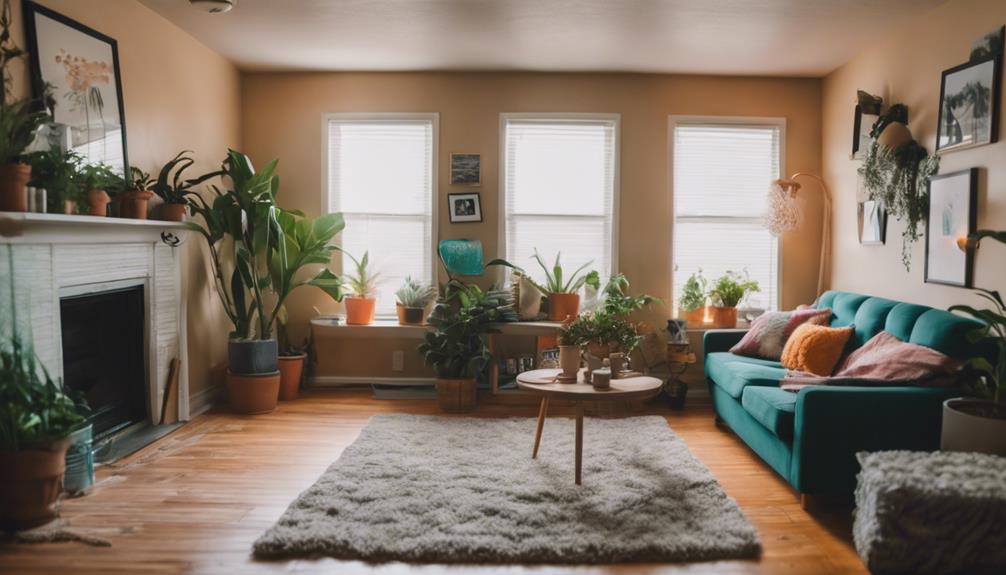Mixing patterns in home decor can be done smoothly! Start by selecting a color scheme of 5-6 hues including primary and accent colors. Vary pattern scales and styles, ensuring colors coordinate across different patterns for a cohesive look. Experiment with mixing techniques by adjusting scale, sizes, and combining different types of patterns. Incorporate various textures strategically to add depth and balance. Reflect your personal style to create a visual flow that feels authentic. Balancing bold patterns with smaller ones, playing with colors, and starting with a shade are key techniques. Stay tuned to discover more expert tips on achieving a perfect mix of patterns in your home!
Key Takeaways
- Balance bold patterns with smaller scales for harmony.
- Coordinate colors across patterns for a cohesive look.
- Start with one shade and mix 3-4 patterns in that color.
- Use a unifying element to tie various patterns together seamlessly.
- Place bold patterns strategically to prevent overwhelming spaces.
Color Scheme and Theory
To achieve a cohesive and visually appealing home decor, curate a color scheme of 5-6 hues that includes 2-3 primary colors and 2-3 accent colors for balance. Selecting a well-thought-out color palette is the foundational step in creating a harmonious space.
By understanding color theory principles, you can elevate your design to a new level. Complementary colors bring visual interest, analogous colors offer harmony, while triadic schemes provide balance. Monochromatic looks exude elegance, and neutral colors add sophistication.
When mixing patterns, your color scheme acts as a guide. Utilize your chosen hues to tie together different patterns seamlessly. By incorporating your primary colors into various elements of your decor, you establish a cohesive look.
Accent colors can then be strategically used to add pops of interest and prevent the space from feeling monotonous. Remember, a well-curated color palette not only enhances your pattern mixing but also sets the tone for your entire design scheme.
Pattern Selection and Coordination

When selecting patterns for your home decor, the key is to find a standout hero print to build around.
Vary pattern scales and mix styles like florals with stripes to create interest and elevate your design.
Focus on coordinating colors across different patterns to achieve a cohesive and harmonious look in your space.
Pattern Variety for Harmony
For a harmonious mix of patterns in your home decor, curate a selection that includes florals, stripes, geometrics, and abstracts for visual interest and cohesion. To achieve this, aim for a pattern variety that encompasses different scales to add depth and balance to your space.
Experiment with combining complementary patterns like floral with stripes or tribal with solid colors to create a cohesive and visually appealing look. When selecting patterns, consider choosing a hero print as the focal point and then mix it with supporting patterns to make sure a well-coordinated design.
Additionally, to maintain harmony within the mix, pick 2-3 primary colors from your chosen color scheme and then incorporate the remaining hues as accent colors in your pattern assortment. By incorporating these elements thoughtfully, you can create a dynamic and visually engaging space filled with a harmonious blend of patterns.
Mixing Styles Creatively
Curate a dynamic mix of styles by creatively selecting and coordinating patterns that reflect your personal taste and aesthetic preferences.
When mixing patterns in your home decor, consider the art of pattern selection to add depth and texture while creating a cohesive look.
Here are some tips to help you master the balance of different styles:
- Pair Contrasting Patterns: Mix floral patterns with stripes or geometric designs to create an interesting visual contrast.
- Experiment with Texture: Combine different textures like velvet, linen, or silk to enhance the richness of your decor.
- Layer Patterns: Try layering different patterns in varying scales to create a visually appealing and dynamic space.
- Blend Styles: Don't be afraid to mix traditional and modern patterns to add an eclectic and personalized touch to your home.
Color Coordination Tips
To achieve a cohesive and visually harmonious look when mixing patterns in home decor, focus on coordinating colors effectively. When incorporating different patterns, it's pivotal to pull them together with a common color palette. By ensuring that patterns share similar color schemes, you can prevent any clashing designs.
One effective strategy is to use repeated colors in various patterns to create visual harmony and a unified space. This approach helps in preventing competing elements and allows you to achieve a cohesive design effortlessly.
When working with bold patterns, consider selecting a dominant color that repeats throughout the different designs. This repeated color acts as a common thread, tying the patterns together and creating a cohesive visual flow.
Whether you're mixing florals, stripes, or geometric prints, color coordination is key to a successful pattern mix. By focusing on colors that complement each other and repeating them strategically, you can confidently combine various patterns in your home decor for a stylish and harmonious look.
Mixing Techniques

When mixing patterns in your home decor, remember the importance of scale variation to create depth and visual interest.
Experiment with different sizes of patterns to define areas and add a dynamic touch to your design.
Consider utilizing color cohesion strategies to guarantee a harmonious and balanced look in your space.
Scale Variation Importance
Varying the scale of patterns in your home decor is a key technique for creating visual interest and depth in your design scheme.
When mixing patterns, consider the following:
- Experiment with Pattern Scale: Play around with large-scale patterns alongside smaller intricate ones to add complexity and richness to your space.
- Define Areas with Scale Variety: Using varying sizes of patterns can help delineate different zones within a room, creating a sense of cohesion and purpose in each area.
- Combine Animal Prints and Geometric Patterns: Mixing animal prints with geometric patterns can result in a visually engaging and dynamic look that brings energy to your decor.
- Create Depth and Balance: Incorporating a range of pattern sizes is essential for achieving depth and balance in your pattern mixing endeavors. By blending different scales, you can create a harmonious and visually appealing design scheme that captivates the eye.
Color Cohesion Strategies
Experiment with combining patterns in your home decor by exploring effective color cohesion strategies. When mixing patterns, curate a color scheme comprising 5-6 hues to guarantee a cohesive look. Opt for 2-3 primary colors and use the remaining shades as accents for a well-balanced palette.
Understanding Color Theory is essential for successful pattern mixing; consider employing complementary colors to add visual interest to your decor. To achieve a harmonious look, try using analogous colors, or opt for triadic color schemes to maintain balance in your pattern combinations.
For an elegant and sophisticated feel, utilize monochromatic schemes in your pattern mixing endeavors. By incorporating these color cohesion strategies based on Color Theory principles, you can confidently mix patterns in your home decor while creating visually appealing and cohesive spaces.
Texture and Material Integration

Integrating various textures and materials in your home decor can elevate the overall appearance and ambiance of your space, creating a dynamic and visually appealing environment.
When it comes to mixing textures and materials in your design, consider the following:
- Experiment with Variety: Try incorporating different textures like velvet, cotton, and silk to add depth and interest to your space.
- Strategic Use of Textures: Use textures strategically to break up patterns and add visual interest to your home decor.
- Consider Fabric Sheen: When integrating different textures and materials, consider the shine of fabrics to guarantee a cohesive design.
- Balance Rough and Smooth: Combining rough and smooth textures can create a balanced composition and enhance the overall aesthetic of your space.
Personal Style and Visual Flow

Embrace your personal style to achieve a cohesive visual flow when mixing patterns in your home decor. Your unique preferences play an important role in creating a space that feels authentic and true to you.
To establish visual flow, repeat colors present in different patterns throughout your decor. This repetition helps connect disparate patterns and harmonize the overall look of a room. Additionally, introduce a unifying element, such as a common shape or motif, to seamlessly tie together various patterns.
In a small room, strategic arrangement of patterns is essential. Place bold patterns in focal points while using more subtle ones in surrounding areas to guide the eye and prevent overwhelming the space.
Pattern Mixing Techniques

Achieving a harmonious blend of patterns in your home decor requires careful balance and thoughtful consideration of color and scale. When mixing patterns, remember these key techniques:
- Balance Bold Patterns: Pair bold patterns with smaller scale or solid patterns to create harmony in your space.
- Play with Colors: Make sure that colors in your patterns are balanced throughout the room for a cohesive look.
- Start with a Shade: Begin with one shade and incorporate 3-4 different patterns in that color to achieve a well-mixed appearance.
- Stick to Color Families: Mixing patterns within the same color family can prevent an overwhelming visual effect in your home.
Pattern Mixing Combinations

For successful pattern mixing combinations in your home decor, consider pairing bold patterns strategically to create a cohesive and visually appealing space. When combining patterns, think about balancing bold designs in one area with complementary patterns in another.
For instance, try matching a patterned sofa with an area rug featuring geometric shapes for a harmonious blend. To add depth and interest, incorporate solid throw pillows in between the bold patterns to create a balanced look.
Experiment with mixing stripes with florals, ikats, geometrics, and solids to achieve a versatile and dynamic design. For example, striped chairs can be paired with a floral patterned area rug to create an engaging visual contrast.
Interior Design Assistance

Explore personalized interior design assistance from Abbey Nolte for expert guidance on decorating dilemmas and pattern mixing challenges.
Whether you're struggling to coordinate fabrics, curtains, furniture, rugs, or upholstery for a cohesive look, Abbey Nolte's team of experienced interior designers is here to help.
By uploading room images and questions, you can receive tailored recommendations to achieve the perfect mix of patterns while maintaining harmony in your space.
Not sure where to find that specific patterned rug or which furniture pieces would complement your existing decor? Get suggestions on where to purchase these items to elevate the aesthetic of your room effortlessly.
With Abbey Nolte's interior design assistance, you can transform your living space into a stylish haven that reflects your personality and design preferences.
Frequently Asked Questions
How to Mix Prints and Patterns in Home Decor?
To mix prints and patterns in home decor, start with a hero print. Combine different scales like large florals with small geometrics. Repeat colors for cohesion, add solids for balance, and draw inspiration from wallpaper patterns.
What Is the Rule for Mixing Patterns?
Mixing patterns is an art form. Balance scales, colors, and textures. Vary sizes for interest. Combine opposites for dynamism. Stick to one color family for depth. Blend bold and subtle for harmony. Aim for balance.
How to Mix Patterns Like a Pro?
To mix patterns like a pro, start with a dominant pattern, vary scales, stick to a common color palette, play with textures, and balance with solid colors. Following these steps will help you create a cohesive and visually appealing home decor. Blending home decor styles can also add an interesting twist to your space. For example, mixing modern and traditional patterns can create a unique and eclectic look. Don’t be afraid to experiment and have fun with it – after all, your home should reflect your personality and style.
How Do You Mix Plaids in Home Decor?
Mixing plaids in home decor is a fun way to add character. Vary scale & color intensity for balance. Pair large & small plaids. Use complementary colors for cohesion. Mix traditional with modern styles for a unique look.
Conclusion
You're now a pattern pro, ready to mix and match with the best of them. Say goodbye to boring, one-dimensional decor and hello to a vibrant, dynamic space that truly reflects your personal style.
With these simple tips and tricks, you'll be turning heads and wowing guests with your bold pattern choices. So go ahead, free your inner designer and create a home that's as unique and exciting as you are!









